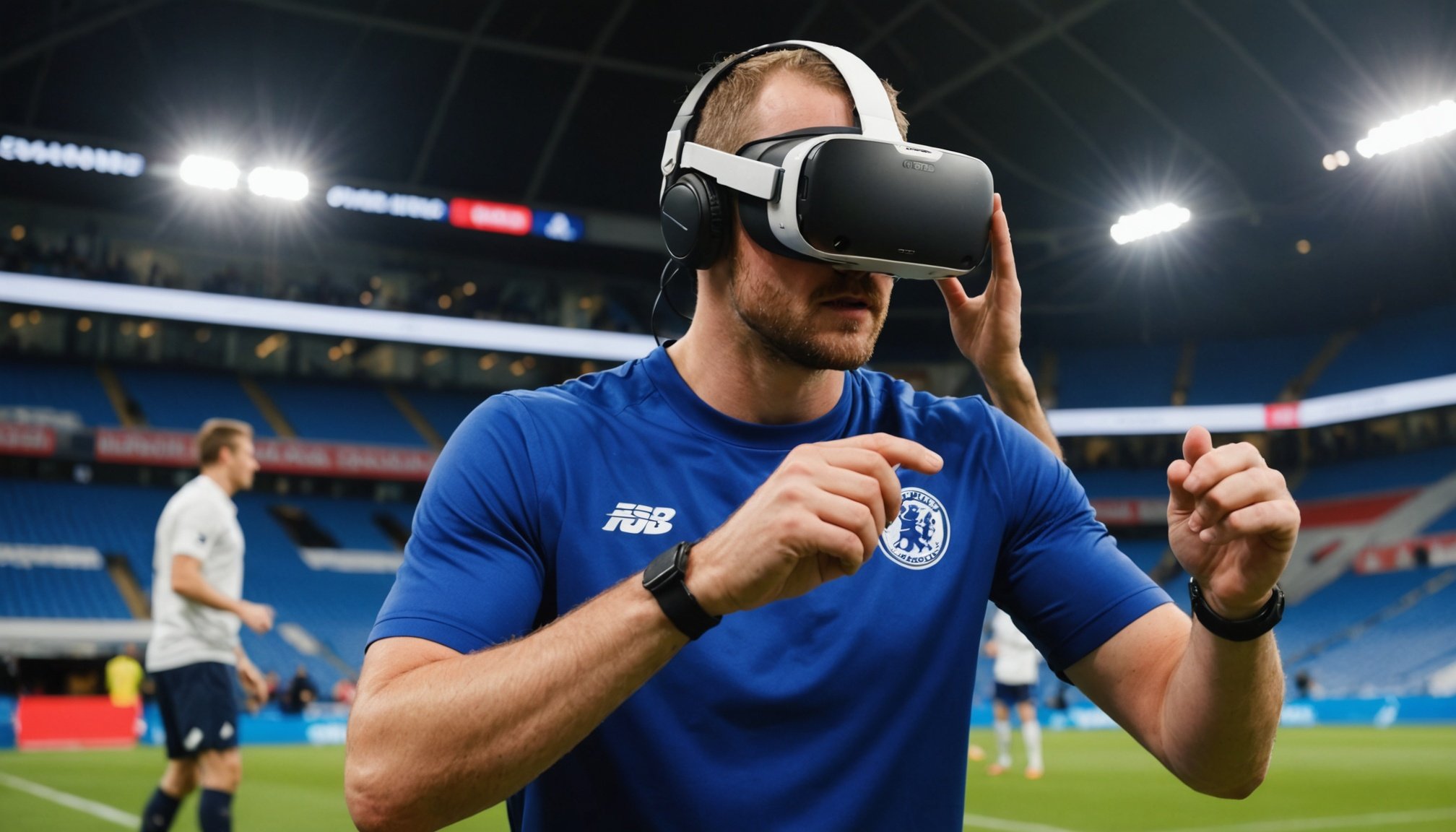Revolutionizing Training: The Role of Virtual Reality in the Development of UK Sports Teams
The Rise of Virtual Reality in Sports Training
Virtual reality (VR) is no longer just a buzzword in the tech world; it has firmly established itself as a game-changer in the sports industry. In the UK, sports teams are increasingly embracing VR technology to enhance their training programs, and the results are nothing short of revolutionary.
How VR is Changing the Game
VR technology is not just about immersing athletes in a virtual world; it’s about creating a highly realistic and interactive environment that mimics real-world conditions. For football players, for instance, VR training sessions can simulate match scenarios, allowing them to practice decision-making skills, tactical awareness, and physical movements in a controlled and repeatable manner.
Also read : Top Recovery Strategies for UK Marathon Runners: Effective Cool-Down Techniques After a Race
“By working closely with Wolverhampton Wanderers Football Club and Rezzil, we’re positioning our researchers to push the boundaries of sports science, gathering data that will offer unprecedented insights into skill development, cognitive performance, and injury prevention,” says Dr. Ross Cloak, Associate Professor at the University of Wolverhampton[5].
Enhancing Athlete Performance with VR
One of the most significant advantages of VR in sports training is its ability to enhance athlete performance across multiple dimensions.
Also to discover : Top Recovery Techniques for UK Cyclists: Essential Post-Ride Strategies for Long-Distance Success
Physical Skills Development
VR training can focus on improving physical skills such as reaction times, agility, and endurance. For example, the University of Wolverhampton’s partnership with Wolverhampton Wanderers Football Club and Rezzil involves using VR to enhance physical, tactical, and technical skills through immersive simulations. These simulations can be tailored to specific game scenarios, allowing players to practice and perfect their movements in a highly realistic environment[5].
Cognitive and Decision-Making Skills
VR is also being used to improve cognitive and decision-making skills. By simulating real-game situations, athletes can practice making quick decisions under pressure. This is particularly beneficial in sports like football, where split-second decisions can make all the difference.
“VR-based training protocols can refine critical game metrics, including player reaction times and decision-making skills,” notes Dr. Ben Greenhough, Head of Research at Rezzil[5].
Data-Driven Analysis and Real-Time Feedback
VR training is not just about the experience; it’s also about the data it generates. Advanced VR systems can provide real-time data and feedback, allowing coaches and athletes to analyze performance more effectively.
Real-Time Data Collection
During VR training sessions, various metrics such as reaction times, movement accuracy, and decision-making speed can be collected and analyzed. This data can be used to identify areas of improvement and to tailor training programs to the specific needs of each athlete.
“For instance, the VR headset can detect even the smallest of eye movements and provide detailed numerical data on metrics such as eye vergence, saccades, and directional accuracy,” explains a report on the use of VR in post-concussion assessments[4].
Performance Analysis
This real-time data can be fed into sophisticated analysis tools, enabling coaches to make informed decisions about player performance and development. Here is a detailed list of how data-driven analysis can benefit sports teams:
- Player Tracking: Real-time tracking of player movements and actions.
- Performance Metrics: Detailed analysis of reaction times, decision-making speed, and movement accuracy.
- Injury Prevention: Identifying potential injury risks through data on player fatigue and physical condition.
- Customized Training: Tailoring training programs based on individual player data.
- Game Strategy: Analyzing game scenarios to develop effective tactics and strategies.
Safety and Injury Prevention
VR technology is also playing a crucial role in safety and injury prevention.
Post-Concussion Assessments
For example, VR is being used in post-concussion assessments to help athletes return to play safely. The Neuroflex VOMS tool, used by Aspetar Hospital in Doha, leverages VR to objectively measure vestibulo-ocular and ocular-motor functions. This helps clinicians to assess the athlete’s readiness to return to the game based on precise numerical data[4].
Injury Risk Reduction
VR training can also reduce the risk of injuries by simulating high-risk scenarios in a safe environment. Athletes can practice movements and actions that might be risky in real-life training without the actual risk of injury.
“Technologies like VR glasses optimize athletes’ performance skills with MR-based games that can be played anywhere and at any time, reducing the risk of injuries associated with conventional training methods,” says Alexander Will, CEO of IMPROVR GmbH[2].
Enhancing the Fan Experience
While VR is primarily used for athlete development, it also has the potential to enhance the fan experience.
Augmented Reality and Virtual Reality Viewing
Fans can engage with sports in new and immersive ways through AR and VR technologies. For instance, VR can allow fans to experience the game from the athlete’s perspective, while AR can project real-time data and statistics onto the viewing screen, enhancing the overall viewing experience.
“The experience of fans in sports has been changed by augmented reality (AR) and virtual reality (VR) technologies. Through VR, fans can engage in an artificial environment where they feel like they are taking part in the game,” explains an article on the role of technology in modernizing the sports industry[1].
Practical Insights and Actionable Advice
For sports teams looking to integrate VR into their training programs, here are some practical insights and actionable advice:
Invest in Quality VR Equipment
- Ensure that the VR equipment is of high quality and comfortable for athletes to use.
- Invest in software that can analyze and provide real-time feedback on athlete performance.
Develop Customized Training Programs
- Use data from VR training sessions to tailor training programs to the specific needs of each athlete.
- Incorporate a mix of physical, tactical, and technical skills into the training programs.
Collaborate with Experts
- Work with sports scientists, coaches, and technology experts to develop and refine VR-based training protocols.
- Share findings and best practices within the sports community to advance the use of VR in sports training.
The integration of virtual reality into sports training is a significant step forward for UK sports teams. By enhancing athlete performance, improving safety, and providing real-time data analysis, VR is revolutionizing the way teams train and prepare for games.
As Dr. Ben Greenhough from Rezzil notes, “This partnership not only allows us to leverage cutting-edge technology to deliver real, impactful insights, but it also reinforces our commitment to supporting research that pushes the boundaries of performance and player welfare”[5].
In the world of sports, embracing new technologies like VR is not just about staying ahead of the curve; it’s about creating a better, more immersive, and more effective training experience for athletes. As VR continues to evolve, we can expect even more innovative applications in the sports industry, transforming the way we train, play, and experience sports.
Table: Comparison of Traditional and VR-Based Training Methods
| Training Aspect | Traditional Training | VR-Based Training |
|---|---|---|
| Physical Skills | Limited by real-world constraints | Simulates real-game scenarios in a controlled environment |
| Cognitive Skills | Limited feedback on decision-making | Provides real-time feedback on decision-making and reaction times |
| Data Analysis | Manual data collection and analysis | Real-time data collection and automated analysis |
| Injury Risk | Higher risk of injury during training | Reduces risk of injury by simulating high-risk scenarios safely |
| Fan Engagement | Limited interactive experience | Enhances fan experience through AR and VR technologies |
| Cost | High costs associated with equipment and facilities | Initial investment in VR equipment, but long-term cost savings |
| Scalability | Limited scalability due to physical constraints | Highly scalable, can be used by multiple athletes simultaneously |
This table highlights the key differences between traditional training methods and VR-based training, showcasing the advantages of integrating VR into sports training programs.











